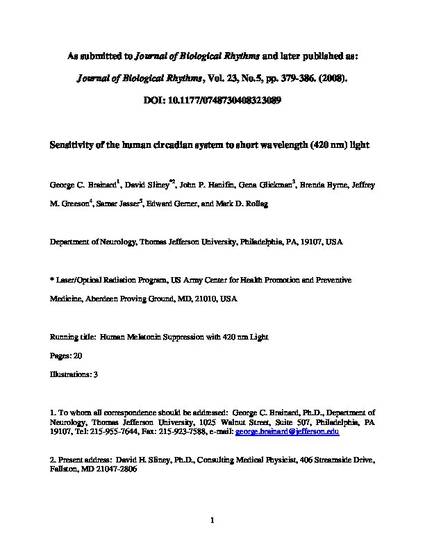
The circadian and neurobehavioral effects of light are primarily mediated by a retinal ganglion cell photoreceptor in the mammalian eye containing the photopigment, melanopsin. Nine action spectrum studies using rodents, monkeys, and human for these responses indicate peak sensitivities in the blue region of the visible spectrum ranging from 459 nm to 484 nm, with some disagreement in short wavelength sensitivity of the spectrum. The aim of this work was to quantify the sensitivity of human volunteers to monochromatic 420 nm light for plasma melatonin suppression. Adult female (N=14) and male (N=12) subjects participated in two studies, each employing a within-subjects design. In a fluence-response study, subjects (N=8) were tested with eight light irradiances at 420 nm ranging over a four log unit photon density range of 1010 to 1014 photons/cm2/sec and one dark exposure control night. In the other study, subjects (N=18) completed an experiment comparing melatonin suppression with equal photon doses (1.21 x 1013 photons/cm2/sec) of 420 nm and 460 nm monochromatic light and a dark exposure control night. The first study demonstrated a clear fluence-response relationship between 420 nm light and melatonin suppression (p<0.001) with a half-saturation constant of 2.74 x 1011 photons/cm2/sec. The second study showed that 460 nm light is significantly stronger than 420 nm light for suppressing melatonin (p<0.04). Together, the results clarify the visible short wavelength sensitivity of the human melatonin suppression action spectrum. This basic physiological finding may be useful for optimizing lighting for therapeutic and other applications.
Available at: http://works.bepress.com/jeffrey-greeson/9/

This article has been peer reviewed. It is the authors' final version prior to publication in Journal of Biological Rhythms Volume 23, Issue 5, October 2008, Pages 379-386. The published version is available at . DOI: 10.1177/0748730408323089. Copyright © SAGE Publications.